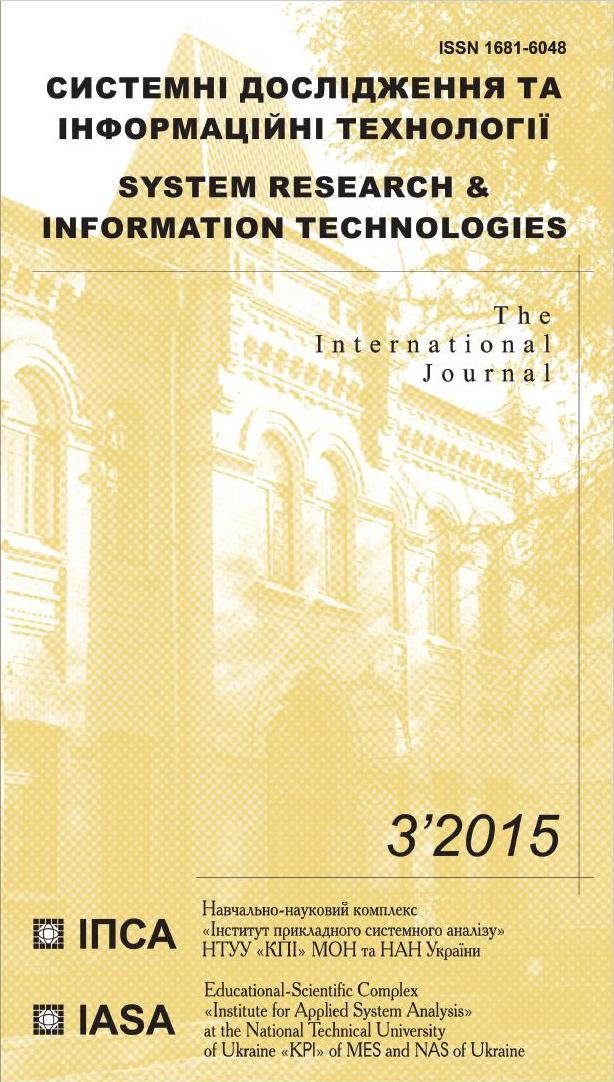Evaluating the confidence intervals for weights of decision alternatives on the basis of expert pairwise comparison judgments
Abstract
The method for evaluation of confidence intervals for weights of decision alternatives on the basis of pairwise comparison judgments, made by an expert, is proposed in the paper. The method is based on an assertion, that expert pairwise comparison judgments represent real ratios of weights of decision alternatives only to some extent and contain the uncertainty, independently of their consistency level. It is supposed that this uncertainty is caused by Saaty scale and such personal qualities of an expert as pessimism and optimism when providing pairwise comparisons. The method is based on the theory of trust (evidence) and results of computer modeling of randomly filled pairwise comparison matrices. The resulted confidence intervals reflect real weights of decision alternatives more reliably in contrast with crisp weights given by the famous analytic hierarchy process. Using com-puter modeling, the resulted confidence intervals are compared with results obtained by known fuzzy prioritization methods.References
Nedashkovskaya N.I. Metod otsenivaniya neopredelennosti ekspertnykh otsenok parnykh sravneniy pri vychislenii vesov al’ternativ resheniy // Problemy upravleniya i informatiki. – 2015. – № 5. – S. 130–142.
Saati T.L. Prinyatiye resheniy pri zavisimostyakh i obratnykh svyazyakh: Аnaliticheskiye seti. Izd. 2-e. – M.: Knizhnyy dom "LIBROKOM", 2009. – 360 s.
Saaty T.L. Decision-making with the AHP: Why is the principal eigenvector necessary // European Journal of Operational Research. – 2003. – 145, № 1. – P. 85–91.
Chandran B., Golden B., Wasil E. Linear programming models for estimating weights in the analytic hierarchy process // Computers & Operations Research. – 2005. – 32. – Р. 2235 – 2254.
Pavlov А.А., Lishchuk E.I., Kut V.I. Matematicheskiye modeli optimizatsii dlya obosnovaniya i nakhodzheniya vesov ob”yektov v metode parnykh sravneniy // Systemni doslidzhennya ta informatsiyni tekhnolohiyi. – 2007. – # 2. – S. 13–21.
Wang Y.M., Parkan C., Luo Y. A linear programming method for generating the most favorable weights from a pairwise comparison matrix // Computers & Operations Research. – 2008. – 35. – P. 3918–3930.
Pankratova N.D., Nedashkovskaya N.I. Method for Processing Fuzzy Expert Information in Prediction Problems. Part I // Journal of Automation and Information Sciences. – 2007. – 39, Issue 4. – P. 22–36.
Pankratova N.D., Nedashkovskaya N.I. Spectral coefficient of consistency of fuzzy expert information and estimation of its sensitivity to fuzzy scales when solving foresight problems // International Journal "Information Technologies and Knowledge". – 6, № 4. – 2012. – P. 316–329.
Pankratova N.D., Nedashkovskaya N.I. Gibridnyy metod mnogokriterial’nogo otsenivaniya al’ternativ prinyatiya resheniy // Kibernetika i sistemnyy analiz. – 2014. – 50, № 5 – S. 58–70.
Wang Y.-M., Elhag T.M.S. A goal programming method for obtaining interval weights from an interval comparison matrix // European Journal of operational research. – 2007. – 177 (1). – P. 458–471.
Sugihara K., Ishii H., Tanaka H. Interval priorities in AHP by interval regression analysis // European Journal of operational research. – 2004. – 158. – P. 745–754.
Debasish Majumder, Joy Debnath, Animesh Biswas. Risk analysis in construction sites using fuzzy reasoning and fuzzy analytic hierarchy process // Proc. Technology. – 2013. – 10. – P. 604–614.
Venkata Rao R. Decision Making in the Manufacturing Environment. Using Graph Theory and Fuzzy Multiple Attribute Decision Making. – Springer-Verlag. – 2007. – http://www.springer.com/gp/book/9781447143741.
Kahraman C. Fuzzy Multi-Criteria Decision-Making. Theory and Applications with Recent Developments. – Springer Science+Business Media, 2008. – P. 591.
Tsyhanok V.V. Metod obchyslennya vah al'ternatyv na osnovi rezul'tativ parnykh porivnyan', provedenykh hrupoyu ekspertiv // Reyestratsiya, zberihannya i obrobka danykh, 2008. – 10, # 2. – S. 121–127.
Nedashkovskaya N.I. Sravnitel’nyy analiz metodov parnogo ekspertnogo otsenivaniya al’ternativ resheniy // Systemni doslidzhennya ta informatsiyni tekhnolohiyi. – 2014. – # 4. – S. 35–44.

